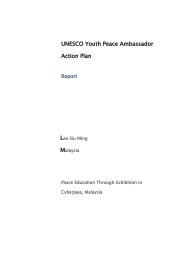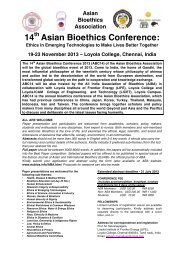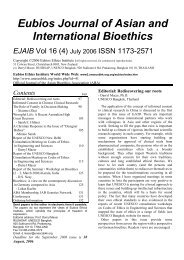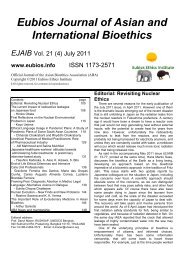Human Dignity, Justice, Fairness, Youth - Eubios Ethics Institute
Human Dignity, Justice, Fairness, Youth - Eubios Ethics Institute
Human Dignity, Justice, Fairness, Youth - Eubios Ethics Institute
Create successful ePaper yourself
Turn your PDF publications into a flip-book with our unique Google optimized e-Paper software.
48 <br />
Macer, DRJ and Saad-Zoy, S. eds., Asia-Arab Interregional Philosophical Dialogues:<br />
<strong>Human</strong> <strong>Dignity</strong>, <strong>Justice</strong>, <strong>Fairness</strong>, <strong>Youth</strong>, Democracy and Public Policy (UNESCO, 2011)<br />
their lives was minimal. On a more personal and moral basis, among the Hindus and the<br />
Buddhist populations as well as the Muslims, it was the religion that governed the<br />
conceptualization of justice. These rural bodies had survived for generations before this time and<br />
they will continue to do so through British India and after that, albeit with an increased hand of<br />
the state in their affairs.<br />
Colonial Period (c. 1600 AD-1950 AD)<br />
The pre-British era in the Indian history that was under the rule of East India Company saw<br />
introduction of the Colonial British courts and tribunals like Mayer’s courts. Around the second<br />
half of 18th century, the House of Commons started taking notice of the business and sociopolitical<br />
affairs of the Company. After receiving a report by a committee, which condemned the<br />
Mayor's Courts, the Crown issued a charter for a new judicial system in the Bengal Presidency.<br />
The British Parliament consequently enacted the Regulating Act of 1773 under which the Kingin-Council<br />
created a Supreme Court in the Presidency town, i.e. Fort William. 6 In the new<br />
Supreme Court, the civil and criminal cases alike were interpreted and prosecuted accorded<br />
to English law; in the Sadar Adalats, however, the judges and law-officers had no knowledge of<br />
English law, and were required only, by the Governor-General's order to proceed according to<br />
equity, justice, and good conscience, unless Hindu or Muslim law was in point, or some<br />
regulation expressly applied.<br />
They had a sideline purpose of favoring the economy of the Company. So, again, the rural India<br />
which formed about 80% of the whole was left to its merit, only now the revenue went in the<br />
treasury of the Company instead of the rulers (who led a nominal role in most of the places and<br />
got remunerations for it). The greatest change-maker introduced was the education system. The<br />
British and other European colonial powers wished to educate the local public so that they can be<br />
a part of the system. But this new education did more than that. It introduced the concept of<br />
rights and duties, albeit not impartially. It showed Indians the ‘flaws’ in their own society. There<br />
was a sort of a renaissance in the social structures with many social activists like Raja Ram<br />
Mohan Roy coming forward trying to uplift the oppressed, the downtrodden and the neglected<br />
people within the community. Long time had it been since man in the Indian subcontinent had<br />
actually been proactive in the betterment of society instead of blaming it all on karma and the<br />
gods. In a way, this sowed the seeds of the concept of ‘equality for all’ as justice in them.<br />
It was like a veil was being lifted off slowly from over their eyes. First were the social<br />
movements from 1860s to 1880s followed formation of different social and political bodies<br />
especially marked by formation of Congress in 1885 and of the Muslim League in 1906. Even in<br />
terms of the change in ideologies and objectives of these bodies, there was continuity. For<br />
example, never had they even dreamed of putting forth the idea of total independence until the<br />
Bombay meeting of Congress in 1931. People still followed their own religion in their homes<br />
and their communities but now their lifestyles were mixed with the European ideas of justice and<br />
freedom, for most of the part. The highlights of this era were the two conflicting ideologies of<br />
Gandhian non-violence and drastic revolution, with the same aim: independence. Incorporation<br />
of non-violence was a phenomenon never seen before in the history of mankind. Mahatma<br />
Gandhiji’s thought behind this idea was to prepare the society so that they can govern themselves<br />
instead of just blindly trying to oust the British (even with a specific ideological dream of future<br />
India). He stopped the whole nation involved in the Civil Disobedience movement because of a<br />
small incident of violence in Chauri Chaura in 1922 saying that the Indian society was not ready<br />
for independence yet. Marching alongside Gandhiji were the brave revolutionaries like Bhagat

















